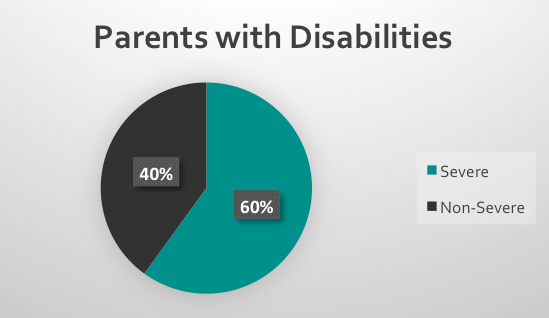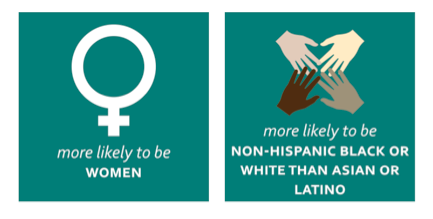Parents With and Without Disabilities: Demographics, Material Hardship, and Program Participation
Download PDF | Plain-language version

Introduction and Background
Comparatively little research has been conducted to understand the economic well-being of parents with disabilities. The bidirectional relationship between disability and poverty is well-established. People who have disabilities are more likely to experience poverty. And families living in poverty are more likely to have children with disabilities. However, the situation of parents with disabilities has not been widely investigated.
In general, disabled US adults experience major economic hardship, and so do children with disabilities and their families.[1] These families are more likely than other families to have food insecurity, housing instability, and difficulty paying their bills.[2] These disability-based disparities in material deprivation persist even when families with disabled members receive public benefits like the Supplemental Nutrition Assistance Program (SNAP or food stamps) and Supplemental Security Income (SSI).[3]
In the present brief, we report on a study of economic barriers parents with disabilities encounter. Our aim with this research was to help policymakers and program coordinators develop inclusive programs and supports for families headed by a disabled parent. Specifically, we wanted to:
- Compare the individual characteristics of parents with severe and non-severe disabilities with parents without disabilities,
- Compare the socioeconomic status and benefit program participation rates of parents with and without disabilities, and
- Identify relationships between parental disability status and poverty.
How the Study Was Done
We analyzed the Survey of Income and Program Participation (SIPP), a nationally representative sample of the non-institutionalized US population, to identify parents with disabilities, their characteristics, and their socioeconomic status. The sixth wave of the 2008 panel, conducted in 2010, provided enough data for us to differentiate between people with severe and non-severe disabilities.
We identified parents with and without disabilities who lived with and cared for their biological, adopted, or step children who were aged 17 or younger.
Findings and Commentary
We found that roughly one in ten parents who live with their children have disabilities. Forty percent of disabled parents had non-severe disabilities, while sixty percent of disabled parents had severe disabilities.

In general, parents with disabilities faced more economic hardship than their non-disabled counterparts, even after accounting other factors. Compared to parents without disabilities, parents with disabilities were, on average …

Parents with severe disabilities had additional differences from parents without disabilities. On average, parents with severe disabilities were…

Parents with both severe and non-severe disabilities also had lower average income and were more likely to have income below the federal poverty line than parents without disabilities.
Families headed by parents with disabilities were more likely to experience food insecurity and receive SNAP and SSI than families headed by parents without disabilities. They were more likely to struggle with rent or mortgage payments, or experience problems with their housing conditions, like faulty plumbing, than parents without disabilities.
Benefits like SNAP and SSI appeared to mitigate economic hardship but did not eliminate it entirely. Employment was also associated with economic hardship, indicating that parents with non-severe disabilities may have fallen into a gap that made their income too high to receive public benefits, but too low to cover all their expenses.
These economic disparities indicate that policymakers should develop programs and services that directly address the financial needs of parents with disabilities. These policies include stipulations that housing be free of disease-causing materials and pests, improved outreach to parents with disabilities about the availability of benefit programs, and larger benefit amounts. The fact that the SSI program does not increase benefit levels when people with disabilities become parents could also be fruitfully addressed by policymakers.
[1] S. Ghosh & S.L. Parish (2013). Prevalence and economic well-being of families raising multiple children with disabilities. Children and Youth Services Review, 35(9), 1431-1439; S.L. Parish, R.A. Rose, and J.G. Swaine (2010), Financial well-being of US parents caring for co-resident children and adults with developmental disabilities: an age-cohort analysis. Journal of Intellectual & Developmental Disabilities, 35, 235, 243.
[2] P. She and G.A. Livermore (2007). Material hardship, poverty, and disability among working-age adults. Social Science Quarterly, 88(4), 970-989.
[3] R.A. Sonik, S.L. Parish, & E.S. Rosenthal (2016). Sibling caregivers of people with intellectual and developmental disabilities: sociodemographic characteristics and material hardship prevalence. Intellectual and Developmental Disabilities, 545(5), 332-341.
Download PDF | Plain-language version
Adapted from Rajan Sonik, Susan Parish, Monika Mitra, and Joanne Nicholson (2018). Parents with and without disabilities: demographics, material hardship, and program participation. Review of Disability Studies, 14(9), 1-20.
